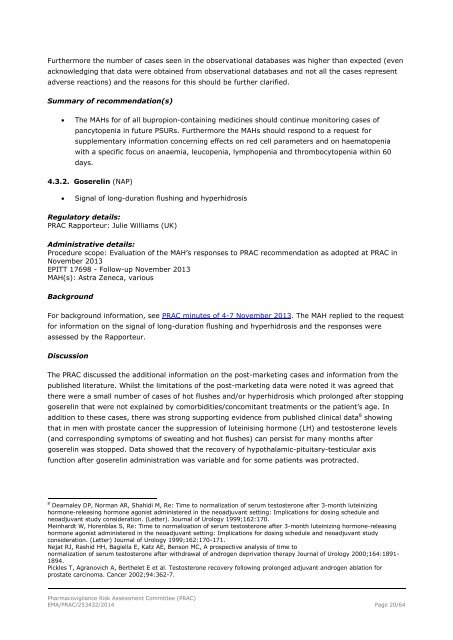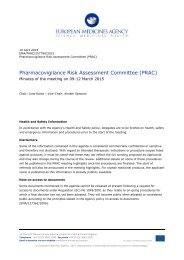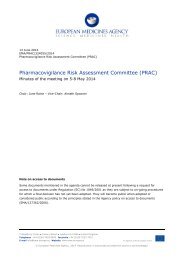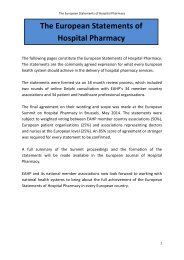WC500165698
WC500165698
WC500165698
You also want an ePaper? Increase the reach of your titles
YUMPU automatically turns print PDFs into web optimized ePapers that Google loves.
Furthermore the number of cases seen in the observational databases was higher than expected (even<br />
acknowledging that data were obtained from observational databases and not all the cases represent<br />
adverse reactions) and the reasons for this should be further clarified.<br />
Summary of recommendation(s)<br />
<br />
The MAHs for of all bupropion-containing medicines should continue monitoring cases of<br />
pancytopenia in future PSURs. Furthermore the MAHs should respond to a request for<br />
supplementary information concerning effects on red cell parameters and on haematopenia<br />
with a specific focus on anaemia, leucopenia, lymphopenia and thrombocytopenia within 60<br />
days.<br />
4.3.2. Goserelin (NAP)<br />
<br />
Signal of long-duration flushing and hyperhidrosis<br />
Regulatory details:<br />
PRAC Rapporteur: Julie Williams (UK)<br />
Administrative details:<br />
Procedure scope: Evaluation of the MAH’s responses to PRAC recommendation as adopted at PRAC in<br />
November 2013<br />
EPITT 17698 - Follow-up November 2013<br />
MAH(s): Astra Zeneca, various<br />
Background<br />
For background information, see PRAC minutes of 4-7 November 2013. The MAH replied to the request<br />
for information on the signal of long-duration flushing and hyperhidrosis and the responses were<br />
assessed by the Rapporteur.<br />
Discussion<br />
The PRAC discussed the additional information on the post-marketing cases and information from the<br />
published literature. Whilst the limitations of the post-marketing data were noted it was agreed that<br />
there were a small number of cases of hot flushes and/or hyperhidrosis which prolonged after stopping<br />
goserelin that were not explained by comorbidities/concomitant treatments or the patient’s age. In<br />
addition to these cases, there was strong supporting evidence from published clinical data 8 showing<br />
that in men with prostate cancer the suppression of luteinising hormone (LH) and testosterone levels<br />
(and corresponding symptoms of sweating and hot flushes) can persist for many months after<br />
goserelin was stopped. Data showed that the recovery of hypothalamic-pituitary-testicular axis<br />
function after goserelin administration was variable and for some patients was protracted.<br />
8 Dearnaley DP, Norman AR, Shahidi M, Re: Time to normalization of serum testosterone after 3-month luteinizing<br />
hormone-releasing hormone agonist administered in the neoadjuvant setting: Implications for dosing schedule and<br />
neoadjuvant study consideration. (Letter). Journal of Urology 1999;162:170.<br />
Meinhardt W, Horenblas S, Re: Time to normalization of serum testosterone after 3-month luteinizing hormone-releasing<br />
hormone agonist administered in the neoadjuvant setting: Implications for dosing schedule and neoadjuvant study<br />
consideration. (Letter) Journal of Urology 1999;162:170-171.<br />
Nejat RJ, Rashid HH, Bagiella E, Katz AE, Benson MC, A prospective analysis of time to<br />
normalization of serum testosterone after withdrawal of androgen deprivation therapy Journal of Urology 2000;164:1891-<br />
1894.<br />
Pickles T, Agranovich A, Berthelet E et al. Testosterone recovery following prolonged adjuvant androgen ablation for<br />
prostate carcinoma. Cancer 2002;94:362-7.<br />
Pharmacovigilance Risk Assessment Committee (PRAC)<br />
EMA/PRAC/253432/2014 Page 20/64








